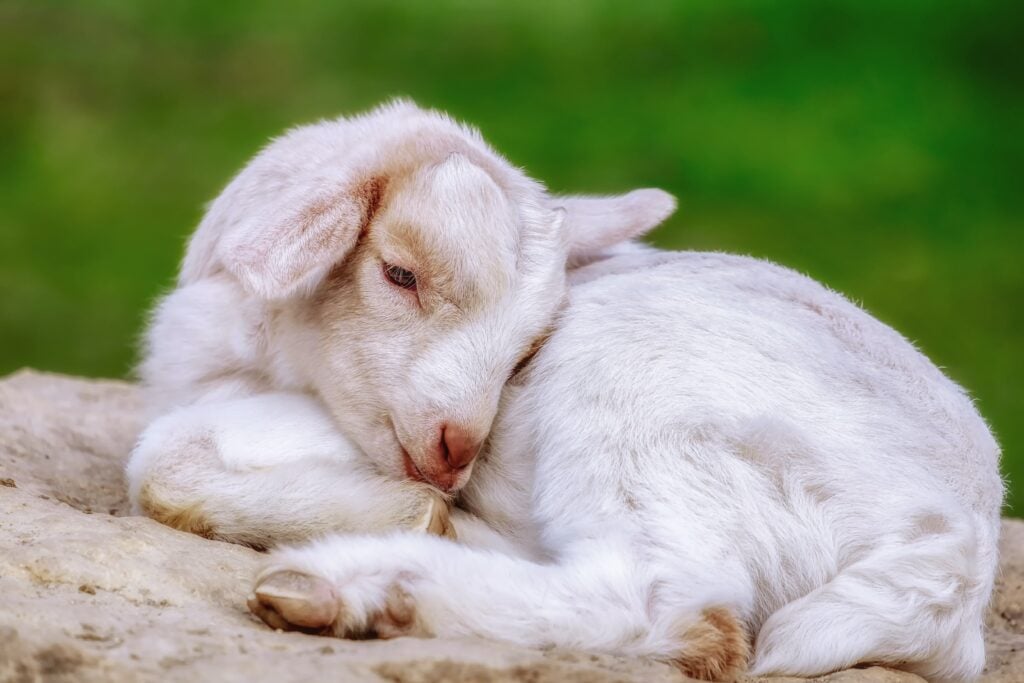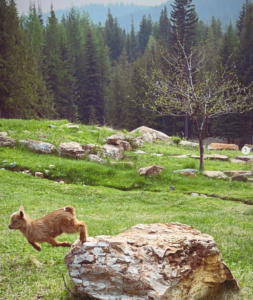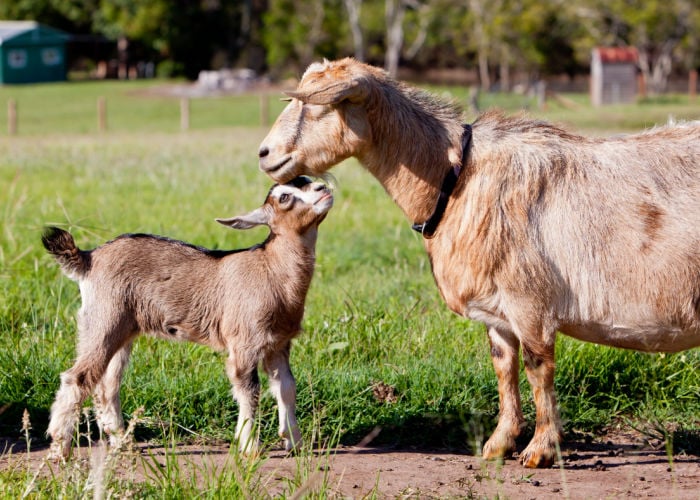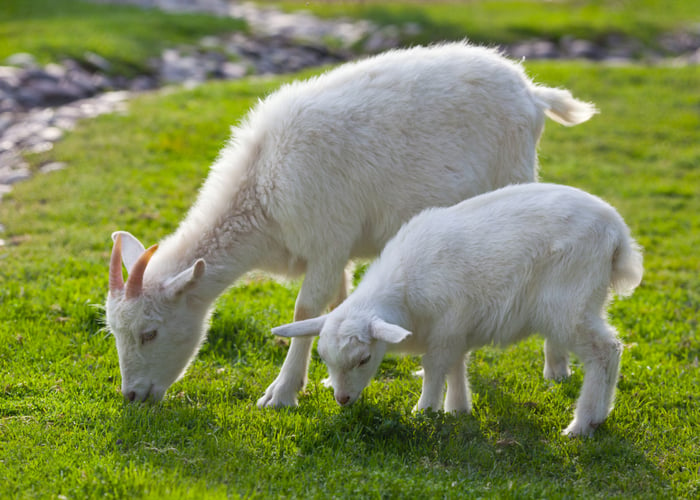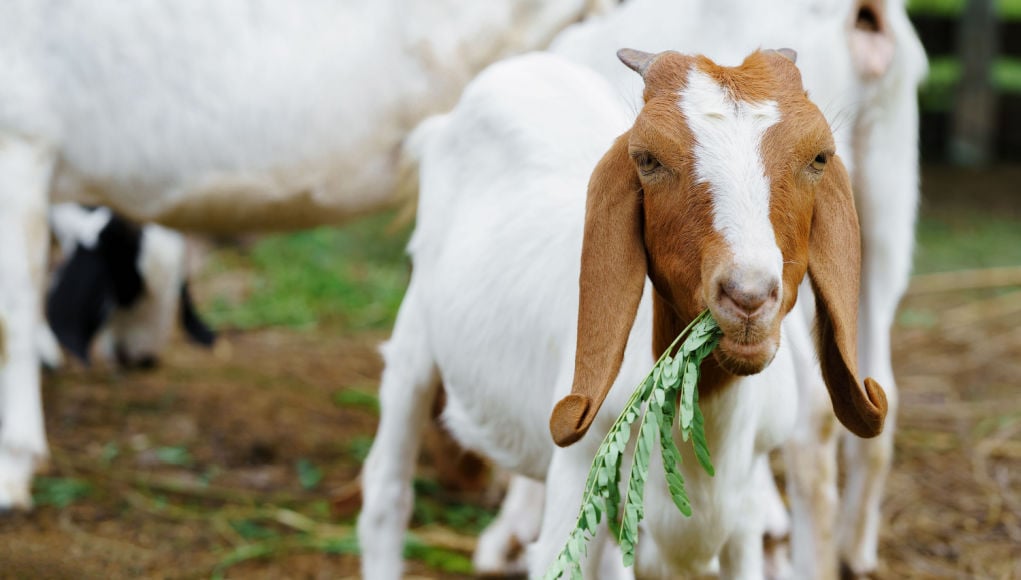Are your baby goats dying?
There are several reasons why kids suddenly fall ill.
熟悉他们,看out for these during the kidding season.
In this article, we covered what causes each issue, prevention measures, symptoms, and treatment whenever possible.
We understand that baby goats dying is distressing and upsetting; use the table of content for faster navigation.
Are Your Baby Goats Dying? Possible Causes
Here are some of the most common baby goat dying symptoms and their causes.

1. Enterotoxemia (The Overeating Disease)
Enterotoxemia, also known as overeating disease or pulpy kidney disease, is a severe condition caused by a specific type of bacteria called Clostridium perfringens type D.
These bacteria naturally exist in the soil and the intestinal microflora of healthy sheep and goats.
However, under certain circumstances, they can rapidly multiply and produce high levels of toxins (basically bacteria poop), leading to enterotoxemia.
Lambs and kids are particularly susceptible to this disease because they haven’t developed strong immunity yet; adult animals usually have some degree of resistance from previous exposure.
Causes
Enterotoxemia can occur when sheep and goats consume excessive amounts of grain-rich feeds or when their immune system is weakened due to other illnesses or stress.
Additionally, heavy infestation with gastrointestinal parasites can increase vulnerability.
Diets low in roughage but high in carbohydrates contribute to enterotoxemia by reducing digestive system motility, greatly raising the risk for goats.
For baby goats, this is brought on by too much milk.
Newborns don’t know when they’re full and sometimes eat or drink more milk than what their stomachs can digest.
The milk basically turns rancid in their stomach, and this strain of bacteria makes them sick.
Enterotoxemia can quickly and unexpectedly cause the death of goats, especially young ones.
That’s why it is important to recognize the signs.
Signs & Symptoms
Symptoms may include loss of appetite, abdominal pain (kicking at the belly), lethargy, and watery or bloody diarrhea.
Affected goats may exhibit unusual behaviors such as repeatedly standing up and lying down, panting, rolling over, crying out, or moving strangely in their enclosure.
In advanced stages, goats may lie on their side with their neck stretched over their withers, indicating the presence of toxins affecting the brain.
Once a goat assumes this position, its passing is imminent, usually within minutes to hours.
Enterotoxemia can progress so rapidly that signs and symptoms may not be observed before the goat is found deceased, especially if it occurs overnight.
Prevention & Treatment
Early intervention can sometimes be successful, but prevention is always better than treatment, as enterotoxemia can progress rapidly and be difficult to reverse.
There is a vaccine available to prevent it called the CDT or three-way vaccine, but it does not work as a treatment.
The best way to treat an affected kid is with analgesics, probiotics, antisera, or oral electrolytes, and then hope for the best.
This is a tough ailment for them to survive.
2. Coccidiosis
Coccidiosis is a common disease affecting goats between 3 weeks and 5 months old, especially when kept in confined spaces.
小山羊在贝尤其敏感ng separated from their mother during weaning.
Cause
This is caused by tiny parasites called coccidia.
These parasites go through a complex life cycle in the intestines, producing many eggs that are passed in the feces.
This can lead to the destruction of intestinal cells and result in diarrhea and other signs of coccidiosis.
Almost all adult goats carry coccidia in their intestines, and the eggs they pass can contaminate the environment.
The infection’s severity depends on the coccidia species’ number and pathogenicity.
Coccidia eggs can become infective within a few days in suitable conditions and contaminate feed and water.
When ingested by other goats, the infective forms invade the intestines and cause damage to the intestinal cells, resulting in coccidiosis symptoms.
Also, young and stressed goats are more susceptible to severe infections.
Be on the lookout for signs and symptoms, especially during weaning, which could be an extremely stressful situation for the kid.
Signs & Symptoms
The signs of coccidia eggs are:
- Appetite loss
- Weight stagnation or loss
- Diarrhea
- Diarrhea containing blood or mucus
- Straining to defecate
- Rough, dull coat
- Death
If goats show no signs of illness, the infection is likely insignificant.
Prevention
Maintaining good sanitation and isolating sick animals is important to prevent the spread of coccidiosis.
Coccidia eggs resist many disinfectants and can survive in the environment for over a year.
They thrive in moist and dark conditions but cannot survive freezing temperatures.
Goats that survive coccidiosis develop some immunity against future infections.
3. Deficiencies
Vitamin and mineral deficiencies are other causes of sick or dying baby goats.
Here are some of the most prevalent deficiencies to consider.
You can prevent most of these by constantly supplying well-rounded mineral blocks in your pasture.
Most 25-pound mineral blocks will supply 10 goats, while 50-pound blocks typically provide enough for 20 goats.
Always read the labels, and make sure the block is intended specifically for goats– not sheep or cattle.
Refer totables 3 and 4 from the Alabama A&M and Auburn Universities Extension.
Copper
Copper deficiencies are common and highly problematic.
While sheep are incredibly susceptible to copper intoxication (really deadly for them), goats must consume 10 to 20 parts per million (ppm) of copper.
Hence, it’s usually impractical to pasture sheep and goats together.
Most mineral blocks that are designed for goats will contain copper, but always read the label before purchasing.
For instance, thisKalmbach 25-pound mineral blockcontains 1,450 to 1,850 ppm of copper and is designed to supply 10 goats, with each goat consuming about 0.5 to 1 ounce of it each day.
With all this said, sometimes the issue isn’t about not providing enough copper — it’s that your animals are incapable of absorbing it.
Goats with higher access to iron, calcium, and sulfur will likely have more trouble absorbing copper.
You can find these counteractive minerals in the hay, alfalfa, water (especially well water), and your pasture’s soils.
Alfalfa is usually the culprit since it’s naturally high in calcium, but this isn’t always the case.
If the mother goat experiences copper deficiency, her kids will suffer from a neurologic condition calledenzootic ataxia, commonly called swayback.
The goat babies may look normal when they are born but have trouble moving properly as they grow up.
Their spinal cords get damaged, which makes them uncoordinated and can lead to paralysis.
This condition is different from another sickness calledcaprine arthritis and encephalitis virus infection, which also affects baby goats’ nervous systems.
Unfortunately, giving copper to the baby goats later won’t fix the problem because the damage is already done.
Affected goats, both adults and kids, might have dull or unhealthy-looking coats, feel tired and weak, lose weight, and have more difficulty during birth.
Vitamin E and Selenium
A Vitamin E deficiency causesWhite Muscle Disease.
White muscle disease (WMD) is a muscle problem that happens in sheep and goats.
It’s caused by not having enough of two important things: selenium and vitamin E.
Selenium is something the animals need, but sometimes the soil they eat from doesn’t have enough of it.
In the US, it’smost common for selenium deficienciesto occur in the Northeast, Northwest, Great Lakes, Atlantic Coastal, and most parts of Florida.
维生素E对他们的身体也很重要,但是it doesn’t depend on the soil.
The kind of food they eat affects their vitamin E levels.
Eating fresh legumes and being out on the pasture can give them enough vitamin E, but when they eat stored feeds like hay or grain, they might not get enough.
All types of sheep and goats can get WMD, but it usually happens to newborn animals or ones that are growing really fast.
Baby goats are especially vulnerable because they need a lot of selenium.
If their mother is deficient, they start life at a disadvantage and continue to struggle until their caretaker adds more to their diet or environment.
So, to keep the animals healthy and prevent WMD, we need to ensure they get enough selenium and vitamin E in their food.
Eating the right plants and ensuring their stored food is fresh can help keep them strong and healthy.
Selenium deficiency alone (not paired with a Vitamin E deficiency) causes weakness in the body and immune system, coughing, milk aspiration, and an inability to stand (the ankles will likely bend backward).

Vitamin B1
Vitamin B1 (Thiamine) deficiency causes tremors, blindness, and staggering in kids.
Thiamine deficiency, or Vitamin B1 deficiency, can cause a problem calledpolioencephalomalaciaor goat polio.
This disease affects the central nervous system, which is the body’s control center.
问题不在于没有足够的满怀mine in their bodies — the problem is their rumen, a part of their stomach, doesn’t produce enough thiamine.
Thiamine deficiency can happen to healthy baby lambs and goats when certain things happen to them.
These things include feeling stressed because of weaning or being moved to a new place, suddenly changing their diet, getting acidosis (when the stomach becomes too acidic), drinking water with a lot of chlorine in it (city or tap water is notorious for this), or being treated with sulfa drugs or Corid.
When animals have a thiamine deficiency, they might suddenly start standing or sitting by themselves, acting like they can’t see properly and looking into space.
They might become confused, lose their appetite, and not want to drink water.
Animals in the later stages of the disease might push their heads against a post, fence, or wall.
They might also lie down with their necks bent over their backs.
Their body temperature might increase, and if they don’t get treated quickly, they will likely die within 48 hours.
This disease can be mistaken for other problems like eating too much, black leg disease, tetanus, or acidosis.
4. Too Hot or Too Cold
It is rarer for a newborn goat to die of excess heat, but it is possible.
Exposure to cold and damp elements is far more likely.
If you’re researching new breeds to add to your operation, consider these — they are themost heat and cold hardy goat breeds.
For goats born into hot climates, make sure they have cool, shaded, and breezy places to escape to.
Shade trees, tall grasses, shaded ponds, and moving water like creeks are excellent.
但如果这不是一个选择,通风良好的酒吧n with box fans and misters works well too, as does air-conditioning.
Cold climates in the winter are usually more deadly.
We have a full guide onhow to keep baby goats warm without electricity. But here is a quick overview:
- Build a Warm Box
- Offer Access To A Draft-Free Barn
- Bring Them Inside Sporadically
- Use Sweaters As Needed
- Use Battery-Powered Webcams or Baby Monitors To Check In
- Carefully Use a Propane Powered Heater
- Try a Generator + Heater Combo
- Consider Moving Your Breeding Season Next Year For Better Results
5. Joint Ill (Navel Ill)
This illness is the result of bacteria entering the young kids’ bodies.
This is usually via the open umbilical cord but can also happen through cuts or tears in the skin, the gastrointestinal tract, or the respiratory system.
This usually occurs in places where the pens where the baby goats are kept during birth are not clean, when there are too many goats in one pen or barn, or when the umbilical cord is not taken care of properly.
Signs & Symptoms
When a baby goat has navel ill, some of its joints become swollen, hot, and hurt a lot.
The baby goat might not be able to put weight on the affected legs or stand up at all.
They might also have a fever but still want to eat their food.
The area around their belly button might look red and swollen, but usually, it doesn’t — this is what throws many people off during diagnosis.
Prevention & Treatment
To help the baby goat get better, they need to take antibiotics, have their swollen joints gently massaged, and rest on a soft, hygienic bed.
They might need to be supported in a sling if they can’t stand up.
The best way to prevent navel ill is to make sure the birthing area is clean, use clean bedding, take care of the baby goat’s umbilical cord, and clean your shoes (or change into sterile ones) before entering the pen where the baby goats are born.
Biosecurity should be the top priority when raising animals.
We coverbiosecurity in greater detail here.
Though the article is chicken-centered, many of these practices will also apply to goat husbandry.
6. Parasitic Worms
All goats have some level of parasitic worms in their bodies, but this population has to be kept in check.
Healthy goats with good rotational grazing management can usually keep this in check naturally.
If you keep your goats on one pasture or dry lot without regular rotation, human interference is needed more often.
A few years ago, it was normal to deworm (or “worm”) on a schedule, but we now know that is not the best practice.
Now, it’s better to deworm goats only as needed to prevent parasitic resistance to the medication.
Be sure to read ourfull guide to safely deworming baby goats; it covers everything from medications to use, natural dewormers to try out, when to deworm, and the best practical application methods.
7. Pneumonia
Pneumonia is a very serious illness that is potentially deadly.
It is one of the main reasons goats get sick, along with having too many parasitic worms in their bodies.
When goats have a lot of worms, their immune system becomes weak, which makes them much more likely to get sick with pneumonia (among other diseases).
Pneumoniais more common in the spring and summer, but it can happen at any time of the year.
It usually happens when the weather changes a lot, like when it gets wet and then hot during the day but cold at night.
Goats, especially baby goats, have a hard time adjusting to these weather changes, and their bodies struggle to stay at the right temperature.
This makes them more likely to get pneumonia than their adult counterparts.
Signs & Symptoms
Interstitial pneumoniais the most common type of pneumonia for baby goats.
The tricky thing about this type is that it doesn’t always show obvious signs like a runny nose or coughing.
Its only symptom is a sudden high fever, sometimes as high as 109°F.
When the fever goes down really quickly and the body temperature falls below 100°F, it means the goat’s lungs are filling with fluid, and it can die very fast.
The goat might look fine at night but be dead by morning. It can happen in as little as four hours.
If you don’t know what your goats usually act like, it’s easy to miss the signs of interstitial pneumonia.
And even if you notice something is wrong, it’s hard to save the goat if you don’t have the right medicine.
Treatment
Fever-reducing medication is a good start, followed by the appropriate antibiotic.
Banimineis best — use 1cc per every 100 pounds of body weight every 12 hours.
If you don’t have that on hand, try baby aspirin (81mg) — three tablets for adult goats or one for baby goats.
Baby aspirin is significantly less effective, so please use Banamine instead if at all possible.
Use Nuflor, Nuflor Gold, or Excenel RTU for respiratory illnesses like pneumonia.
Carefully follow the instructions on the bottle prior to use.
As you can imagine, it’s far better to keep medications like this on hand before they are needed.
8. Birth Defects
Sometimes there is little to nothing that you can do to save dying baby goats.
That’s a sad and difficult reality of raising livestock.
Some birth defects are invisible to the human eye, especially if the internals of the baby are not properly formed.
With that said, not all birth defects are unavoidable.
Vitamin deficiencies and poor management, especially in the pregnant mother, can cause deadly birth defects.
Read the above section on deficiencies to avoid those; readthe definitive guide to raising goatstoo.
Knowing the best practices makes it easier to understand and better manage your herd with fewer incidents and fatalities.
9. Premature Birth
Premature birth in goats happens for many reasons: malnutrition, selenium deficiencies, chlamydia (feral birds, ticks, and mosquitoes can cause this), toxoplasmosis gondii (spread by cat feces), or overwhelming stress may lead to premature labor and delivery.
The best way to prevent premature birth is to keep the mother goats in a low-stress environment, with plenty of well-balanced forage/nutrition, clean & fresh water, and prevent biosecurity breaches whenever possible.
Keep their barns and pastures as clean as possible, and do not let cats or birds near your pregnant does.
If your goat has a premature baby, there are a few things you can do to try to save it.
When a baby goat is born too early, the major issue is usually its lungs.
Inside the lungs, there are small balloon-like structures called alveoli. These alveoli are important for getting oxygen into the blood.
But sometimes, they stick together and can’t inflate properly, meaning no oxygen can enter the blood.
There is a special substance calledsurfactantthat helps keep the alveoli from sticking together.
However, this substance is not produced enough until very late in the pregnancy.
Without enough surfactant, the lungs may inflate briefly but then stick together again, and oxygen cannot get through.
So how do we treat this problem?
Since most premature babies have trouble breathing, the most important thing is to provide them with oxygen.
Putting them in an incubator and giving them 100% oxygen can help some babies.
There are also certain medicines, like Dexamethasone or Betamethasone, that can be given to the baby to help its cells produce more surfactant.
This treatment is usually done in an incubator with 100% oxygen, and the medicine helps the baby’s lungs develop faster.
How to Help Premature Baby Goats
A lot of veterinary clinics are unable to get to our goats in time or even have what we need to save the new kid.
An old farmer’s trick is to take the unconscious newborn (or seemingly stillborn) kid by grabbing the two front feet in one hand and the two back feet in the other and then spinning in a fast circle for just a moment.
Sometimes this knocks some air into the kids’ lungs, allowing them to inflate.
Sometimes they just have a lot of mucus and water in their airways that needs to come out.
Yes, this bizarre motion cures both issues almost immediately.
Basic treatment for a breathing premature baby involves a few important things.
First, since premature babies can’t control their body temperature, we need to provide a warm and safe environment for them to help them stabilize.

Next, we need to make sure they get the right nutrition.
Premature babies may be unable to suckle on their own, so we may need to use a tube to feed them.
Tube-fed babies may transition to nursing from their mother, but this could lead to a need for exclusive bottle-feeding.
How To Help The Mama Goat After Kidding
Some premature births are actually late-term abortions.
In these instances, the baby goat dies inside the mother, and then the mother gives birth to the body earlier than anticipated afterward.
In either case, you should watch the doe closely to ensure she passes all of the kids and placentas (afterbirth) so she doesn’t get an infection and die.
How To Save a Baby Goat From Dying
The best way to save a dying baby goat is to identify the source problem and take appropriate action quickly.
Prevention is always better than reaction, so read up on the best practices for raising goats, implement healthy goat-rearing methods, build a comprehensive goat first aid kit, and know the signs of as many afflictions, diseases, and issues as possible.
If possible, find an experienced goat mentor or a knowledgeable veterinarian (or vet tech) who you can call in an emergency.
What To Do If Your Baby Goat Dies
If your baby goat dies, try to figure out what caused the death.
This can prevent loss in the future and potentially save your other goats if this affliction is contagious or the result of a specific malnourishment or deficiency.
Baby Goat Carcass Disposal
Proper carcass disposal is an unpleasant but necessary part of raising livestock.
Your options are burial, incineration, cremation, composting, or hauling it to an appropriate landfill.
Always bury animals at least two feet in the ground, and never in an area with a high water table.
Never dump animals in or near bodies of water, including flood-irrigated fields.
Also, never bury animals within 100 feet of a well or spring.
There are pet cemeteries and crematoriums, so look for those in your area if you’re interested in that option.
Another alternative is to take your animal to the landfill if your landfill accepts livestock.
This is usually the best option for areas with large predators, like bears, wolves, and mountain lions — burying or dumping livestock on your land will call these animals in, where they may later hunt your other livestock.
Burning carcasses is encouraged in some areas and prohibited in others due to clean air acts.
If you’re unsure what to do for your area, get in contact with other goat farmers, veterinarians, or your county extension agent. They can usually point you in the right direction.
Interested in reading more articles about baby goats? Check out our recommendations below!
